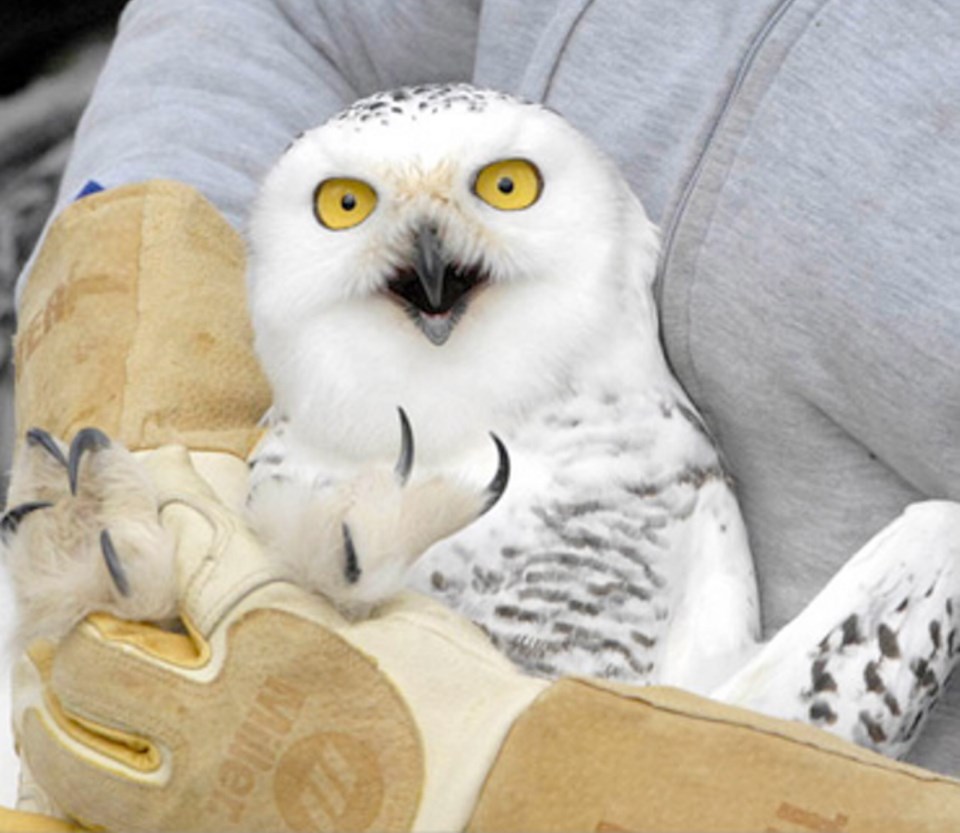Out of six rescued snowy owls the Mountainaire Avian Rescue Society has handled, Oscar is the only one to have survived.
The young male is looking much more handsome these days after his release Friday. He had spent the last three months recovering at MARS and rumour has it there is a single white female snowy owl in the vicinity of his release site, close to the Shelter Bay Distillery by the old UBC farm lands south of Campbell River.
Named after the Muppet character on Sesame Street, Oscar was found in Port Hardy last November, severely emaciated and near death.
He was nursed back to health by MARS volunteers and released Friday back into the wild. Weighing in at a mere 800 grams when he was found and too weak to move, Oscar is the only survivor out of six starving snowy owls rescued by MARS this season. He weighs a healthy 1.6 kg. today.
"He was tube-fed fluids and a vitamin mix throughout the night during his first 10 days with us," said a spokesperson for MARS. "We gradually introduce a ‘slurry of meat’ when the birds are able to digest it. Their favourite meal is lemmings, but we do not serve those here."
In a cyclical pattern called irruptions, half-starved snowy owls have been flying 1,500 kilometers or more to Vancouver Island in search of food.
"They're all starving," said the MARS volunteer. "By the time they get down here, they're usually very thin. We're finding them one-half to one-quarter of their normal weight. They might look okay because they are beautiful looking birds with gorgeous feathers, but underneath they can be skeletal."
Ironically, it can be an abundance of Arctic lemmings that contributes to a food shortage for the next generation. Well-fed females lay up to 11 eggs in 11 days, with up to seven hatching into chicks. That population boom, in turn, creates a shortage of food, with the parents staying behind and this year's crop of snowies seeking food farther and farther afield.
Last year, there was a large number of snowy owls found starving in the Lower Mainland. This year it seems Vancouver Island is their destination of choice.
The yellow-eyed black-beaked snowy owls typically nest north of the tree line in the tundra and high arctic, and they are usually a rare sight in B.C.
The birds migrate from the Arctic tundra every few years, but are being seen in places they have never been seen before, such as B.C., Texas, Kansas and Nebraska. The owls return to the tundra in the spring, for breeding season.
Out of their Arctic element, snowies seek open spaces to hunt on the Island, including airport lands, or even rooftops, as they find the forest unfamiliar. As inexperienced hunters, "for every mouse they catch, they miss 10" a MARS volunteer said.
If there is a scarcity in the food supply, these birds will survive for a period of six weeks because of the fat reserved in their bodies. They usually eat lemmings, arctic hare, ptarmigan, squirrels, raccoons, rats, moles, shorebirds, gulls, songbirds and ducks.
MARS is a non-profit, charitable organization and they rescue ill, injured, orphaned or oiled wildlife and transport for rehabilitation and eventual release.



